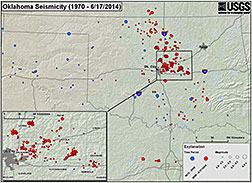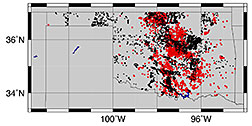- Number 437 |
- April 20, 2015
Under pressure: What’s causing the shake-up?

This seismicity map of earthquakes in
Oklahoma since 1970 shows activity of at
least 3.0 magnitude on the moment
magnitude scale with pre-2008 events in
blue and post-2008 events in red.
(Courtesy of the U.S. Geological Survey)
Until recently, Oklahoma was not known as a hotbed for earthquake activity. Historically, California has been more famous for tremors, but last year Oklahoma surpassed California in seismic activity. What is causing this increase in seismicity? DOE's National Energy Technology Laboratory is combining its expertise in geology, computer modeling, and predictive sciences to find answers.
NETL and Virginia Tech gathered information on seismic activity dating from 1882 to 2014 (website of data compiled available here). Researchers compared this information to data on the locations of hydraulic fracturing sites and waste water injection wells. Their findings disagree with the popular perception that hydraulic fracturing causes earthquakes. The majority of well operations, like fracking, cause no increase in seismic activity, although a relationship does exist between some waste water injection wells and earthquake activity. This correlation indicates the possibility of induced seismicity—or earthquake activity that corresponds to human activity.
The rock beneath the Earth’s surface contains fractures and pores. Fluid injection into these spaces increases pressure within the rock. Changes in the existing pressure can cause rock to move, shearing along the fractures and causing earthquakes. Most of these earthquakes cannot be felt at the surface, but several larger earthquakes have been recorded that researchers believed to be associated with high-volume waste-water injection.

A map of Oklahoma shows earthquakes in
red and waste water injection wells in black.
(Courtesy of the Virginia Tech Seismological
Observatory)
Dr. Dustin Crandall, Research Engineer, emphasized that it’s not hydraulic fracturing causing the vast majority of induced seismic events, but “the injection of large volumes of waste water that are pulled back up from the subsurface after hydraulic fracturing is over.”
NETL is working to provide a clearer picture of the possible causes of induced seismicity by creating a detailed picture of the subsurface and performing modeling to link injection rates and locations to changes in the subsurface pressure. This research will help inform industry about when and where larger seismic events could occur from hydraulic fracturing and waste water injection—information that can point to optimum injection sites for minimizing the effects of induced seismicity.[Linda Morton, 304.285.4543,
Linda.morton@netl.doe.gov]
